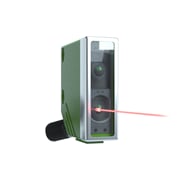Colour sensors and contrast sensors
Photoelectric colour & contrast sensors detect colours and grey levels through use of multicoloured light. The desired colour or grey level is progr. at touch of a button on the sensor. Device adjusts automatically to ensure optimum recognised of desired colour/ grey level Particularly suitable for fast counting & sorting tasks. Read more here
Colour sensors and contrast sensors
All items of the category Colour sensors and contrast sensors:
How colour sensors work
Colour sensors reliably detect objects of the adjusted colour in using multi-coloured light. The multi-coloured light (red, green and blue) is directed onto the object to be detected and reflected by the object. The colour sensor calculates the chromaticity coordinates from the reflected beams and compares them with the adjusted reference colour values. If the measured colour values are within the adjusted tolerance range of the reference colour values, the sensor switches. That way objects can be sorted and detected by their colour and control and presence detection of objects of the adjusted colour is possible.
Ranges of applications of colour sensors
- Object sorting by colour
- Object detection by colour
- Control and quality inspection
- Presence detection by the adjusted colour of the object to be detected
How do contrast sensors work?
Contrast sensors use multi-coloured light (red, green or blue) to detect contrasts and differences in brightness. They do not only distinguish between black and white but smartly select the best colour of the emitted light to detect minute differences in brightness. It does not mater whether grayscales shall be distinguished or if for example a light red distinguished from a dark red. The sensor is taught to reliably detect the desired surface and differences in contrast.
Ranges of applications of contrast sensors
Contrast sensors are predominantly used in packaging and printing machines (for example in labelling and packaging processes in the food industry) and to detect pressure marks. The very high switching frequency of the sensor enables use with extremely fast processes and production of large quantities.




 Cloud compatible
Cloud compatible


